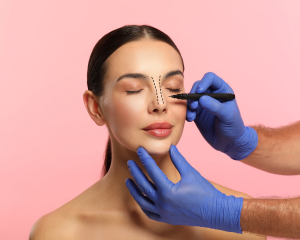
Can Rhinoplasty in Beverly Hills Correct Breathing Problems?
Rhinoplasty, commonly known as a nose job, has long been associated with cosmetic enhancements to achieve a desired aesthetic appearance. However, rhinoplasty not only addresses cosmetic concerns but also proves to be a solution for individuals experiencing breathing difficulties.
This article explores the dual purpose of rhinoplasty in the renowned Beverly Hills region, exploring how this procedure goes beyond mere aesthetic enhancement to serve as a functional remedy for breathing problems.
Overview of Rhinoplasty in Beverly Hills
Beverly Hills, synonymous with luxury and glamour, has emerged as a hub for cosmetic and reconstructive surgeries, with rhinoplasty gaining popularity among individuals seeking facial harmony. Surgeons in this affluent enclave are not only skilled in refining the external appearance of the nose but are increasingly focusing on improving its internal functionality.
Dual Purpose: Aesthetic Enhancement and Functional Improvement
Traditionally, rhinoplasty is primarily aimed at reshaping the nose to meet aesthetic preferences. However, the evolution of this procedure in Beverly Hills reflects a broader approach, emphasizing the importance of functional improvements. Surgeons are now addressing issues, such as a deviated septum, nasal valve collapse, and other structural abnormalities that hinder proper airflow. This dual-purpose approach not only enhances the overall facial aesthetics but also tackles underlying breathing difficulties, providing patients with a comprehensive solution to their concerns.
Understanding Rhinoplasty
Definition and Scope
Rhinoplasty, a surgical procedure designed to alter the shape and structure of the nose, has evolved beyond its initial cosmetic focus. In the context of Beverly Hills, renowned for its emphasis on beauty and sophistication, rhinoplasty has become a comprehensive solution that addresses both aesthetic concerns and functional issues related to nasal health.
The historical context and evolution of rhinoplasty techniques highlight the procedure’s transformative journey. Originally developed to reconstruct noses damaged by injury or disease, rhinoplasty has transcended its reconstructive roots. Today, it encompasses a wide range of surgical approaches aimed at enhancing the visual appeal of the nose while simultaneously addressing functional aspects.
Primary Objectives
- Aesthetic Refinement for Facial Harmony: At its core, rhinoplasty in Beverly Hills is a sought-after procedure for achieving facial harmony and balance. Surgeons employ advanced techniques to reshape the nose in accordance with the patient’s unique facial features, creating a more proportionate and aesthetically pleasing appearance. The emphasis on aesthetic refinement aligns with the discerning tastes of individuals in Beverly Hills, where beauty standards are often synonymous with sophistication.
- Correction of Functional Issues, Including Breathing Difficulties: In addition to its cosmetic objectives, rhinoplasty now plays a pivotal role in correcting functional issues associated with the nasal passages. Beyond enhancing external aesthetics, surgeons in Beverly Hills are equipped to address internal concerns, such as a deviated septum, nasal valve collapse, and other structural abnormalities that impede proper airflow. The integration of functional improvements distinguishes Beverly Hills rhinoplasty as a holistic approach to nasal health, ensuring that patients not only look better but also breathe better.
Functional Aspects of Rhinoplasty
Common Breathing Problems
In the pursuit of both aesthetic refinement and functional improvement, it is essential to understand the common breathing problems that individuals in Beverly Hills may seek to address through rhinoplasty. Two prevalent issues are often encountered:
- Deviated Septum and Nasal Obstruction: A deviated septum, a condition where the wall between the nostrils is off-center, can significantly impede airflow. This structural abnormality may result from genetics, injury, or a combination of factors. Individuals experiencing a deviated septum often encounter nasal obstruction, leading to difficulties in breathing through one or both nostrils.
- Turbinate Hypertrophy and Its Impact on Airflow: Turbinate hypertrophy refers to an enlargement of the nasal turbinates, which are structures inside the nose that help regulate airflow and humidity. When these turbinates become excessively enlarged, they can obstruct the nasal passages, causing breathing difficulties. Turbinate hypertrophy may result from various factors, including allergies, infections, or chronic nasal congestion.
- Internal Valve Dysfunction: Internal nasal valve dysfunction occurs when there’s a narrowing or collapse of the nasal passages. This dysfunction impairs airflow and causes breathing difficulties. Symptoms include nasal congestion, difficulty breathing through the nose, and chronic nasal obstruction. Internal valve dysfunction is common with structural abnormalities, injury, and previous nasal and revision rhinoplasty surgeries. Treatment options include nasal valve surgery, septoplasty, rhinoplasty, or nonsurgical interventions like nasal dilators.
Role of Rhinoplasty in Functional Improvement
To address these common breathing problems, rhinoplasty in Beverly Hills incorporates specific surgical techniques aimed at functional improvement. The procedures focus on rectifying internal nasal structures to enhance airflow and alleviate breathing difficulties.
- Septoplasty – Correcting Deviated Septum: Septoplasty is a surgical procedure performed to correct a deviated septum. During this process, the surgeon carefully straightens and repositions the septum, allowing for improved alignment of the nasal passages. By addressing the deviated septum, septoplasty not only enhances airflow but also alleviates nasal obstruction, providing individuals with a significant improvement in breathing function.
- Turbinate Reduction for Enhanced Nasal Airflow: Turbinate reduction is another facet of rhinoplasty that targets functional improvement. This procedure involves the strategic removal or resizing of hypertrophied turbinates, ensuring that they no longer impede nasal airflow. By reducing the size of the turbinates, surgeons can create more open nasal passages, facilitating improved breathing for individuals who may have previously experienced congestion and obstruction.
Comprehensive Evaluation
Preoperative Assessment
Before undergoing rhinoplasty in Beverly Hills, individuals embark on a comprehensive preoperative assessment that involves careful consideration of both aesthetic and functional aspects. This crucial step ensures that the surgical plan addresses the unique needs and goals of each patient.
- Consultation with an Experienced Rhinoplasty Surgeon: The journey towards rhinoplasty begins with a thorough consultation with an experienced and specialized rhinoplasty surgeon. During the consultation, patients can discuss their concerns, desired outcomes, and any breathing difficulties they may be experiencing.
- Diagnostic Tools and Imaging for Functional Analysis: In pursuit of functional improvement, advanced diagnostic tools and imaging techniques play a pivotal role in assessing the internal nasal structures. Surgeons utilize tools such as endoscopy and nasal airflow studies to conduct a detailed functional analysis. These assessments provide valuable insights into the specific issues affecting nasal function, such as a deviated septum or turbinate hypertrophy.
Customization of Procedure
Tailoring rhinoplasty to address both aesthetic and functional concerns is a hallmark of the approach taken in Beverly Hills. The customization of the procedure is a crucial aspect that allows individuals to achieve a harmonious balance between their desired aesthetic outcomes and the resolution of functional issues related to breathing difficulties.
- Tailoring Rhinoplasty to Address Both Aesthetic and Functional Concerns: The aesthetic component involves reshaping the external appearance of the nose to achieve facial harmony, considering factors such as nasal proportions, symmetry, and overall facial balance. Concurrently, the functional aspect focuses on correcting internal structural issues that may impede proper airflow. This dual approach ensures that patients not only attain their desired aesthetic outcomes but also experience a noticeable improvement in breathing function.
- Importance of Open Communication Between Surgeon and Patient: The success of a customized rhinoplasty procedure relies on open and transparent communication between the surgeon and the patient. Beverly Hills surgeons prioritize establishing a collaborative relationship with their patients, encouraging them to express their aesthetic preferences, concerns, and any issues related to breathing difficulties. This dialogue allows the surgeon to gain a comprehensive understanding of the patient’s goals and tailor the procedure accordingly.
Surgical Techniques for Functional Improvement
 Rhinoplasty in Beverly Hills incorporates specific surgical techniques aimed at not only achieving aesthetic refinement but also addressing functional aspects for improved breathing. Two key procedures that play a vital role in functional improvement are septoplasty and turbinate reduction.
Rhinoplasty in Beverly Hills incorporates specific surgical techniques aimed at not only achieving aesthetic refinement but also addressing functional aspects for improved breathing. Two key procedures that play a vital role in functional improvement are septoplasty and turbinate reduction.
- Septoplasty: Septoplasty is a surgical technique designed to correct a deviated septum, a common issue contributing to nasal obstruction and breathing difficulties. During this procedure, the surgeon carefully straightens and repositions the septum, the wall between the nostrils. By aligning the septum properly, septoplasty enhances the internal structure of the nose, leading to improved breathing and airflow. This corrective measure not only facilitates better nasal function but also alleviates the symptoms associated with a deviated septum, such as nasal congestion and difficulty breathing through one or both nostrils.
- Turbinate Reduction: Turbinate reduction is a surgical intervention focused on addressing turbinate hypertrophy, the enlargement of nasal turbinates that can obstruct nasal passages. Surgeons perform this procedure by strategically reducing the size of hypertrophic turbinates, creating more open nasal passages, and alleviating nasal congestion and obstruction. By diminishing the size of these structures, turbinate reduction enhances nasal airflow, contributing to an overall improvement in respiratory function. This procedure is particularly beneficial for individuals who may experience chronic nasal congestion or difficulties breathing due to enlarged turbinates.
Recovery and Aftercare
The postoperative phase of rhinoplasty in Beverly Hills is a crucial period during which individuals undergo the healing process, ensuring optimal results in both aesthetic and functional aspects. Managing postoperative discomfort and adhering to a carefully outlined timeline for resuming normal activities and exercise are integral components of the comprehensive aftercare provided in this esteemed locale.
- Managing Postoperative Discomfort: Following rhinoplasty, individuals may experience some degree of postoperative discomfort, including swelling, bruising, and mild pain. Surgeons in Beverly Hills typically employ advanced techniques to minimize these effects, but it is essential for patients to follow specific postoperative care guidelines. This may involve the use of prescribed medications to alleviate pain and reduce swelling.
Cold compresses and elevated sleeping positions can also contribute to a more comfortable recovery. Regular follow-up appointments with the surgeon allow for ongoing assessment and adjustments to the postoperative care plan as needed.
- Timeline for Resuming Normal Activities and Exercise: The timeline for resuming normal activities and exercise is carefully outlined to ensure a smooth recovery process. While each patient’s recovery is unique, a general timeline provides a guideline for returning to various activities:
- First Week: Patients typically experience the most significant swelling and may need to take time off work or social activities. During this period, gentle activities such as walking are encouraged, while strenuous exercises should be avoided.
- 2-4 Weeks: As swelling gradually subsides, individuals can begin to engage in light exercises, such as walking or stationary biking. However, activities that involve bending over or activities that increase blood flow to the face should still be avoided.
- 4-6 Weeks: Most patients can resume more strenuous exercises, but caution is advised to avoid any activity that could impact the nose. Sports that involve potential contact with the nose or activities that cause significant facial movement may need to be postponed.
- 6 Weeks Onward: By this point, individuals can usually resume all normal activities, including more intense exercises and sports. However, it is crucial to follow the specific recommendations provided by the surgeon and gradually reintroduce activities to ensure a safe and effective recovery.
Conclusion
Beverly Hills rhinoplasty is characterized by a meticulous approach that tailors the procedure to address both aesthetic and functional concerns. The result is a harmonious nasal profile that not only captivates in appearance but also facilitates optimal respiratory function.

 Rhinoplasty in Beverly Hills incorporates specific surgical techniques aimed at not only achieving aesthetic refinement but also addressing functional aspects for improved breathing. Two key procedures that play a vital role in functional improvement are septoplasty and turbinate reduction.
Rhinoplasty in Beverly Hills incorporates specific surgical techniques aimed at not only achieving aesthetic refinement but also addressing functional aspects for improved breathing. Two key procedures that play a vital role in functional improvement are septoplasty and turbinate reduction.